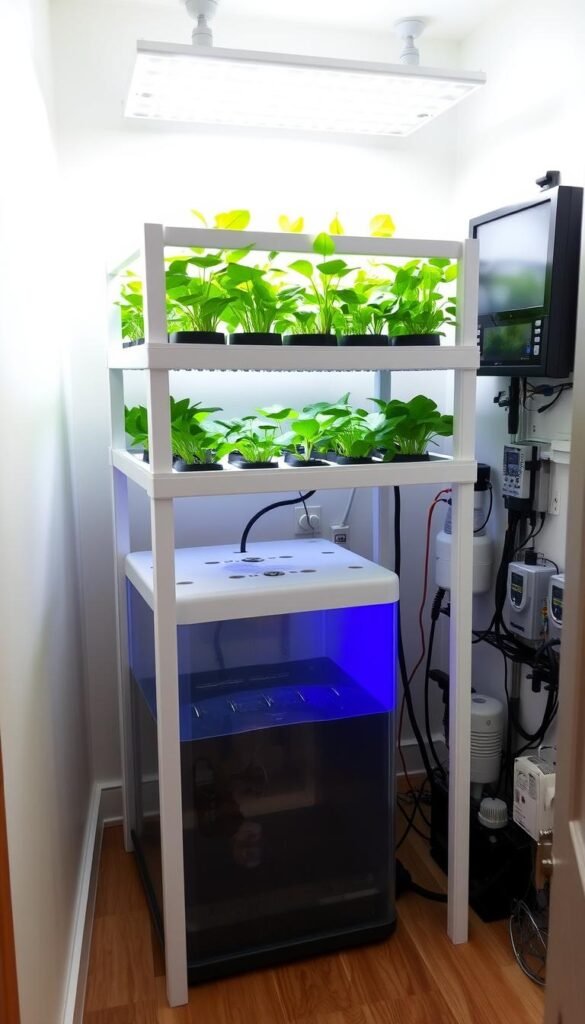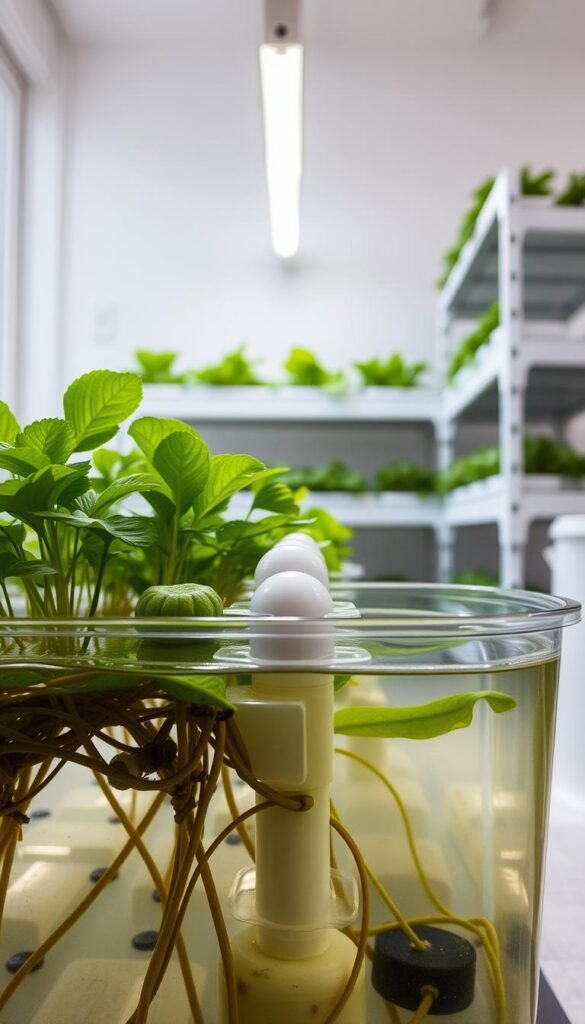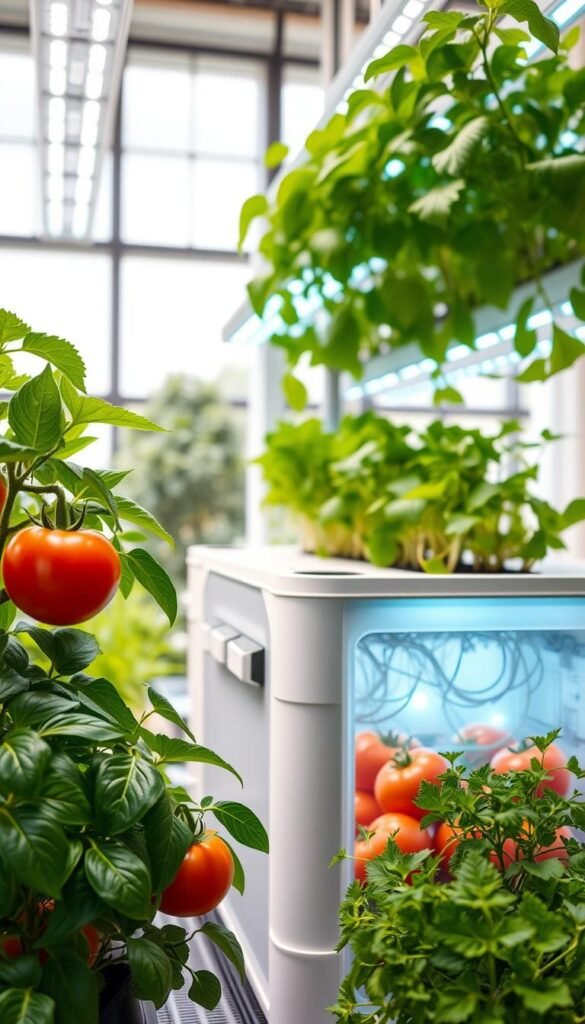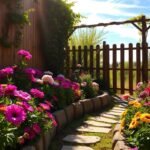Imagine harvesting fresh herbs, leafy greens, or juicy tomatoes year-round – even if you live in an apartment. Soil-free growing lets you cultivate plants faster while using 90% less water than traditional methods. This approach works perfectly for balconies, countertops, or spare corners, turning tight areas into productive green zones.
Instead of dirt, your plants thrive in a nutrient solution delivered through a simple system. You’ll control every variable, from light exposure to pH levels, ensuring optimal growth. Many setups fit in spaces under 3 square feet, making them ideal for urban dwellers or anyone craving homegrown food without a backyard.
This guide walks you through selecting the right containers, managing nutrients, and maximizing your harvests. You’ll discover how to:
- Choose space-saving systems like vertical towers or floating raft designs
- Prevent water waste with recirculating reservoirs
- Boost yields using targeted light schedules
Key Takeaways
- Hydroponics grows plants 30-50% faster than soil gardening
- Compact systems use 10x less space than traditional plots
- Precise nutrient control prevents waste and boosts plant health
- Recirculating water systems reduce usage by up to 90%
- Adjustable LED lights optimize growth in tight spaces
Ready to transform that unused nook into a thriving garden? Let’s explore the tools and techniques that make small-scale hydroponics both practical and rewarding.
Introduction to Hydroponic Gardening in Small Spaces
Transforming limited areas into lush gardens is simpler than you think. Hydroponic gardening grows plants directly in water enriched with minerals, skipping soil entirely. “This method delivers nutrients 3x faster to roots compared to dirt-based growing,” notes a 2023 urban agriculture study.

How It Works Without Soil
Your plants sit in net pots while their roots absorb a customized nutrient solution. No digging or weeding required. Closed-loop systems recirculate water, cutting usage by up to 90% versus outdoor plots.
Why Urban Growers Love It
Apartment dwellers gain three key advantages:
- Zero soil-borne pests invading your basil or lettuce
- Vertical towers produce 8x more greens per square foot
- LED lighting lets you garden in windowless corners
Small-scale setups thrive with just 2-4 hours of daily attention. You control every variable – pH levels, oxygen flow, and feeding schedules – ensuring plants reach maturity 30% faster on average.
Key Components of a Hydroponic System for Compact Setups
Every efficient hydroponic system relies on core components working together. Your setup’s success depends on matching these elements to your available space and crop choices. Let’s break down the essential parts that turn limited areas into productive gardens.

Containers, Reservoirs, and Net Pot Systems
Your container acts as the system’s backbone. Many growers use 5-gallon buckets or plastic storage bins – they’re affordable and fit snugly in corners. The reservoir stores the nutrient solution, keeping roots fed without constant refills.
Net pots solve two problems at once. They:
- Support plants above the water
- Allow oxygen to reach developing roots
Choose containers with opaque walls to prevent algae growth. Dark-colored bins work best for protecting water nutrients from light exposure.
Choosing the Right Substrate and Nutrient Solutions
Your substrate choice impacts how well plants absorb food. Popular options include:
- Perlite – improves air circulation
- Coconut coir – retains moisture effectively
- Clay pebbles – reusable and pH-neutral
Pre-mixed nutrient solutions simplify the process. They contain precise ratios of nitrogen, phosphorus, and potassium. Test pH weekly – most crops thrive between 5.5 and 6.5. “Balanced nutrition prevents 80% of common growth issues,” notes a 2024 urban farming report.
Pair these components with proper light exposure, and you’ll create a self-contained ecosystem. Compact systems prove you don’t need acres to grow plants effectively – just smart design choices.
Setting Up Your Hydroponic System: A Step-by-Step Guide
Building your own deep water culture setup takes less than an hour with basic tools. This beginner-friendly method keeps roots submerged in oxygen-rich water, accelerating growth rates by 40% compared to soil gardening. Let’s break down the process using everyday items.

Simple DIY Deep Water Culture Methods
Start with a 5-gallon bucket – dark colors prevent algae growth. Cut holes in the lid using a 2-inch hole saw to hold net pots. Fill these pots with clay pebbles for root support and moisture retention. Mix your nutrient solution according to package instructions, then fill the bucket until 1 inch of the net pots are submerged.
Choose your aeration method:
| Passive Aeration | Active Aeration |
|---|---|
| Uses air gap between water and lid | Requires air pump and stone |
| Best for leafy greens | Ideal for fruiting plants |
| No electricity needed | Boosts oxygen by 70% |
Ensuring Proper Support and Aeration
Secure plants using polystyrene boards if lids aren’t available – just ensure 30% of the roots touch the solution. For active systems, connect an air pump to a stone using silicone tubing. “Proper aeration prevents root rot and doubles nutrient uptake,” explains a 2024 hydroponic guide.
Maintain your system with these tips:
- Check water levels daily – top up with pH-balanced liquid
- Use LED lights 12-16 hours daily for optimal growth
- Keep temperatures between 65-75°F for healthy roots
This setup lets you grow up to 6 plants in a 2-square-foot area. Adjust your containers and lighting as your garden expands – the principles remain the same whether you’re using buckets or custom-built troughs.
High‑Yield Strategies for Small‑Space Hydroponic Gardening
Efficient growth in limited spaces hinges on precise environmental control. Three factors determine your success: light quality, temperature consistency, and water movement. Master these, and you’ll see plants reach maturity faster while producing more vegetables per square inch.

Optimizing Light, Temperature, and Water Flow
Your lighting choice directly impacts growth speed. LED panels outperform fluorescent bulbs by providing:
| Feature | LED | Fluorescent |
|---|---|---|
| Energy Use | 40% less | Higher |
| Lifespan | 50,000 hours | 10,000 hours |
| Best For | Fruiting plants | Seedlings |
Set timers to mimic natural daylight – 14 hours on for tomatoes, 12 for leafy greens. Keep water between 65-70°F using aquarium heaters in cooler rooms. A small pump ensures nutrient solution circulates properly, preventing stagnation.
Pruning Techniques and Plant Care for Maximum Growth
Regular trimming redirects energy to productive areas. Snip yellowing leaves every 3-4 days using sterilized scissors. For bushy herbs like basil:
- Cut above leaf nodes to encourage branching
- Remove flower buds to prolong harvests
- Thin overcrowded stems weekly
Test your solution every 48 hours – adjust pH to 5.8-6.3 for most crops. “Consistent care prevents 60% of common yield issues,” advises an urban farming expert. Pair these methods with proper airflow, and you’ll transform cramped setups into powerhouse producers.
Choosing and Preparing the Best Plants for Hydroponic Success
Your plant choices make or break your compact hydroponic garden’s productivity. Focus on species that thrive in water-based environments and match your available space. Fast-growing varieties with shallow roots deliver the best results for beginners.
Top Performers for Tight Spaces
Leafy greens and herbs dominate small systems. Lettuce grows 30% faster in hydroponics than soil, while basil develops fuller flavor profiles. Consider these factors when selecting:
- Growth speed – harvest lettuce in 3 weeks vs. 7 in dirt
- Root depth – kale needs 6″ space vs. 4″ for spinach
- Light needs – mint tolerates lower light than parsley
Compare seed-starting methods with this simple guide:
| Method | Starter Cubes | Soil Starts |
|---|---|---|
| Transition Time | Direct to system | 3-day root rinse |
| Contamination Risk | Low | High |
| Cost | $0.10/plant | $0.25/plant |
Match container size to mature plant dimensions. A 12″ deep bin supports full-size bok choy but wastes space on microgreens. “Oversized reservoirs slow growth by 15%,” warns a 2024 indoor farming study.
Space plants using these guidelines:
- Leaf lettuce – 6″ between crowns
- Herbs – 4″ spacing in vertical towers
- Dwarf kale – 8″ diameter per plant
Adjust your nutrient solution strength as plants mature. Young seedlings need 50% concentration, increasing weekly. Proper selection lets you grow plants that yield 8-10 harvests annually in the same water-based setup.
Lighting and Nutrient Management for Vibrant Growth
Your plants’ health depends on two critical factors: the quality of their light diet and the precision of their nutrient intake. Just like humans need balanced meals and sunlight, hydroponic crops thrive when these elements work in harmony. 
Smart Lighting Choices for Every Stage
LED panels dominate modern setups for good reason. They use 40% less energy than fluorescent tubes while offering customizable spectrums. Need to boost flowering in tomatoes? Switch to red-dominant light. Growing leafy greens? Blue wavelengths accelerate leaf production.
| Light Type | Best For | Cost Over 5 Years |
|---|---|---|
| Full-Spectrum LED | All growth stages | $180 |
| T5 Fluorescent | Seedlings/herbs | $310 |
| HID | Large fruiting plants | $420 |
Position lights 12-18 inches above plants using adjustable hangers. “The right height prevents light burn while maximizing photosynthesis,” advises a 2024 indoor farming report.
Mastering the Nutrient Balance Act
Your nutrient solution acts like a personalized vitamin mix. Test pH daily with digital meters – most plants prefer 5.8-6.3. If levels drift:
- Add pH Up/Down solutions gradually
- Wait 2 hours before retesting
- Adjust pump flow rates if using automatic dosers
Change the entire solution every 2-3 weeks to prevent salt buildup. For leafy greens, use higher nitrogen formulas. Fruiting plants like tomatoes crave extra potassium during flowering. Track changes in a journal – yellow leaves often signal nutrient imbalances rather than light issues.
Pair these strategies with consistent water temperature checks (65-70°F ideal), and you’ll create a thriving ecosystem. Your plants will reward you with faster growth and higher yields – no backyard required.
Advanced Techniques for Indoor and Outdoor Hydroponics
Elevate your harvest potential by stacking plants skyward. Vertical hydroponic systems multiply your growing area without expanding your footprint.
Sky-High Gardening Strategies
Wall-mounted towers and modular shelves let you grow 10 plants in the space of one. A 2024 study found vertical setups produce 2.5x more herbs per square foot than horizontal layouts. Here’s how to optimize:
- Use rotating racks to ensure even light distribution
- Install drip trays under stacked containers to recycle water
- Pair slim reservoirs with low-energy pumps for quiet operation
Outdoor vertical gardens thrive with these adjustments:
| Indoor Systems | Outdoor Systems |
|---|---|
| LED panels every 18″ | South-facing placement |
| Humidity control | Wind-resistant frames |
| pH checks every 3 days | Rainwater diversion |
Keep nutrient solution flowing smoothly in tall setups. Tiered drip systems work best for 5+ foot structures. “Multi-level gardens need 30% faster flow rates,” advises urban farming expert Lisa Yang. Monitor roots weekly – compact designs can tangle if not pruned.
Try these space-smart containers:
- Hanging PVC pipe gardens for strawberries
- Stackable crates with wicking fabric
- Repurposed shoe organizers for microgreens
Common Challenges and Proven Solutions in Hydroponic Systems
Even well-designed setups sometimes face hiccups. Don’t panic – most issues have simple fixes when caught early. Let’s explore practical ways to keep your system running smoothly.
Quick Fixes for Frequent Frustrations
Murky water often signals trouble. Test these three factors first:
| Issue | Check | Solution |
|---|---|---|
| Algae Growth | Light leaks in container | Wrap reservoirs in foil |
| Weak Plants | pH levels | Adjust to 5.8-6.3 |
| Clogged Pump | Debris in lines | Flush with vinegar |
Nutrient imbalances show through leaf changes. Yellow edges? Add magnesium. Purple stems? Boost phosphorus. Change your solution every 14 days to prevent salt buildup.
Keep roots healthy with these steps:
- Trim brown sections weekly
- Maintain water temps at 68°F
- Use air stones for oxygen
For pump failures, clean intake screens monthly. Keep spare parts like tubing connectors handy. “Regular maintenance prevents 70% of mechanical issues,” notes an urban farming guide.
Conclusion
Your journey to fresh, homegrown produce starts with smart design. By combining efficient systems with precise nutrient solutions, you can grow vibrant plants in corners others overlook. Remember – success lies in balancing water flow, light exposure, and root support.
Recirculating setups slash resource use while boosting growth rates. Vertical layouts multiply yields without expanding footprints. Whether nurturing leafy greens or herbs, proper pH management ensures your crops thrive.
Start small but think big. Apply the setup tips and maintenance routines from this guide to avoid common pitfalls. Experiment with plant spacing or LED schedules – your unique space might inspire new efficiencies.
Now’s the time to transform that unused shelf or balcony nook. Grab your containers, mix your first batch of nutrient solution, and watch your compact garden flourish. With these methods, you’ll enjoy fresh harvests while mastering sustainable hydroponic gardening.






